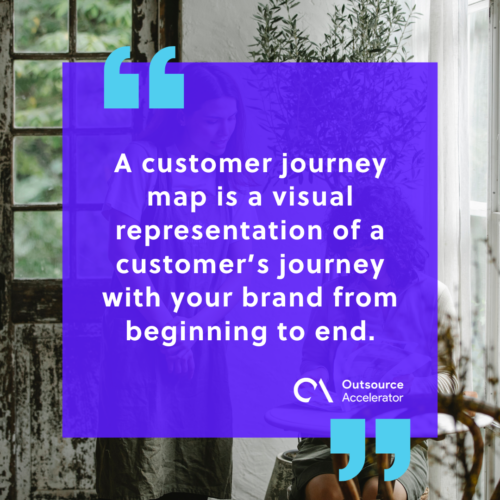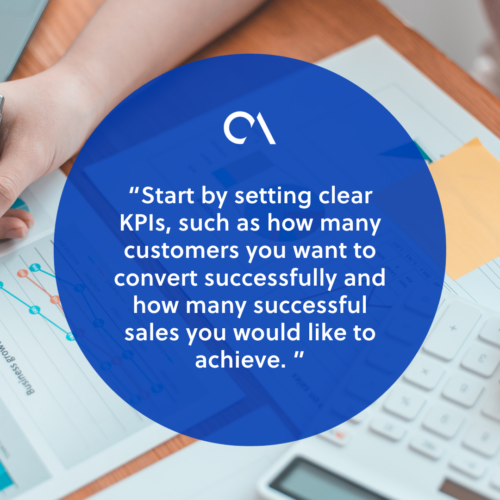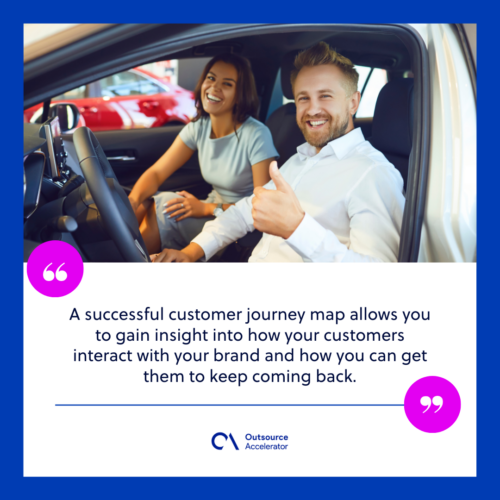A complete guide to B2B customer journey mapping

Having a bird’s eye view of your customers allows you to gain insight into their behaviors and patterns.
One effective way to do this is by creating a customer journey map, highlighting all the important moments of a buyer’s journey.
In this article, learn more about creating a B2B customer journey map.
What is a customer journey map?
A customer journey map is a visual representation of a customer’s journey with your brand from beginning to end.
Customers’ journey can start with their realization that they have a problem or pain point that they need to resolve. It then ends with them choosing your products or services as the solution.

Why you need a B2B customer journey map
A customer journey map documents consumers’ interactions with a B2B brand, giving them a cohesive overview of the time spent with the business.
The brand’s leaders use this map to gain information on how to improve the customers’ journey and encourage them to remain in the sales funnel.
By creating this map, businesses have a clearer picture of the customers:
- Likes and dislikes
- What they are responsive to
- Their goals
Potential B2B leads could be lost throughout the journey, and creating this map helps you identify ways to prevent that from happening.
Keeping track of how the customer behaves and in what aspects the business lacks can also be applied to new customers.
Implementing what they learned from their journey map helps businesses ensure more customers gained than lost.
How to create a B2B customer journey map
A customer journey map includes several stages that highlight the most pivotal moments. Here is a breakdown of what to include in your map:
Identify your own goals
As a business, defining your own goals from the start can be the foundation of your customer journey map.
Start by setting clear KPIs, such as how many customers you want to convert successfully and how many successful sales you would like to achieve.

Create a buyer persona
Figure out who your customers are by creating personas for them, as this helps you understand your target audience better.
A buyer persona consists of the buyer’s age, gender, career, interests, or anything else to help you learn more about them.
Define customer touchpoints
A customer touchpoint refers to any time consumers interact with your brand, whether they buy something or are simply aware of it.
These touchpoints come in different journey stages.
- Awareness – Ads, word of mouth, or blog posts
- Consideration – Product descriptions, website visits, social media
- Conversion – Reviews, product demos, user experience
- Support – Live chat, support agents
- Advocacy – Organic social media, surveys, loyalty programs
Take note of which touchpoints your business offers and include them in your journey map.
Conduct customer research
You can only create a customer journey map using information you already have. Gathering data from customer research helps you create a fuller, more detailed journey map.
You can gather data on your customers through interviews, surveys, or by working with a team or an outside firm to conduct in-depth market analysis and research.
Map out journey stages
The five stages mentioned above are the main phases in a customer journey. Align each stage with your sales funnel.
Awareness is a significant stage where a customer first sees or hears of the brand’s name or products via ads or word of mouth. Grabbing their attention is the most important step.
This followed by consideration, where a customer debates whether a product or service will help address their needs.
After careful consideration, they may be converted to an official customer and make a purchase. This is followed by support where the customer seeks to make the most of their product by contacting support teams or turning to live chat support.
Lastly, advocacy or retention is when a now-loyal customer continues buying the company’s products and refers them to others.
Gather feedback
Gathering feedback from new and existing customers helps you improve your journey map and see where you are lacking or if there are changes you need to make.
Check if there are any areas where your customers fall out of the sales funnel and adjust accordingly to get them back in.
You can use different analytics tools to track your KPIs and spot the gaps in your journey. Some metrics to measure include:
- Net promoter score
- First call resolution rate
- Customer conversion rate
- Customer lifetime value
- Retention rate
Importance of B2B customer journey mapping
A successful customer journey map allows you to gain insight into how your customers interact with your brand and how you can get them to keep coming back.

It helps you identify what your customers need at each stage of the buying journey and gives you ideas on giving them the best experience possible.







 Independent
Independent




